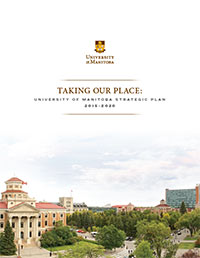|

|

|
- Make the University of Manitoba the institution of first choice for potential students, staff and faculty.
|
- Expand the pool of outstanding potential students, staff and faculty applying to the University of Manitoba.
- Retain the University of Manitoba's status as one of Manitoba's Top 25 Employers.
|
- Increase student, staff, faculty and leadership diversity that reflects society, especially with respect to the inclusion of women, Indigenous peoples, people with disabilities, gender and sexual minorities, and racialized minorities.
|
- Work toward appropriate student, staff and faculty gender balance in all academic programs.
- Increase the number of Indigenous students, staff and faculty.
- Build a culture of inclusion so that our leadership reflects the diversity of society.
|
- Increase student, staff and faculty satisfaction with the learning and work environment.
|
- Create initiatives designed to promote a respectful work and learning environment.
- Pursue best practices for provision of childcare and healthy living options for students, staff and faculty.
- Enhance common spaces, amenities and services to better meet the needs of the university community.
- Improve workload distribution to ensure staff are able to maintain an appropriate work-life balance consistent with their career objectives.
- Ensure all faculty, staff and students receive regular feedback to support individual growth, development and success.
|
- Develop a culture of leadership and teamwork among our students, staff and faculty through professional development programs.
|
- Increase professional development, leadership and growth opportunities for students, staff and faculty.
|
- Create a learning and work environment that meets the needs of the University's future, recognizes the Indigenous reality of Manitoba, integrates with surrounding communities, and supports environmental and resource sustainability.
|
- Balance staff and faculty levels to meet academic and administrative requirements.
- Ensure Campus Master Plans and campus development provide access to facilities for those with disabilities, demonstrates leadership in social, economic and environmental sustainability, and supports a growing learning and research enterprise.
- Improve the quality and level of maintenance of the University's physical spaces.
- Make Indigenous culture, language and symbols visible throughout our campuses.
|
- Provide information technology systems that support the needs of students, staff and faculty.
|
- Continue to renew information technology infrastructure to better support teaching, learning and research programs.
|
- Ensure university governance processes are meaningful, transparent, engaging and effective in advancing the University's mission and strategic priorities.
|
- Improve opportunities for participation in university governance, particularly for students, staff and junior faculty.
|
- Develop a culture of continuous dialogue, collaboration, and consensus building to improve communication and inform institutional development within the context of stable or diminishing resources.
|
- Develop robust processes for input from students, staff and faculty in the development of new administrative programs and systems.
- Better link planning and resource allocation in the support of the University's academic mission and priorities.
|
- Enhance and support meaningful connections between faculties and units within the University.
|
- Increase opportunities for cross-faculty/unit participation in projects and events to build a stronger sense of community.
|






